These highlights chronicle the year 2023. The year runs generally
"backwards" on this page. In crediting records of vagrant or unusual birds, I always try to credit the finder(s) of the rarity. There will be times when complications arise with credit (e.g., one or more observers find a bird but others are the ones to actually identify it). There are times when a bird is properly identified only days later after photo review.
The abbreviation "MTY" means "Monterey County"
in the text below. Text by Don Roberson. Photos on this page
are copyrighted by the photographers to whom they are
attributed, and may not be reproduced in any form (including
other web sites) without the express consent of the photographer. |
| |
| |
September was very good for vagrants in 2023, even better than September 2022, when there was a chasable Kentucky Warbler plus a Prothonotary Warbler & Great Crested Flycatcher on 1 Oct. [Oct-Nov 2022 would bring two Yellow-green Vireo and two Pine Warbler!].
Yet September 2023 would have a first and second MTY record, as detailed below. September 2023 also saw an unprecedented incursion of Orchard Oriole that winged their way to north-coastal MTY. There were at least 13 Orchard Oriole between 3 Sep-1 Oct, sometimes even two together (e.g., photo right 29 Sep © Don Roberson, one of two at the Russian church bridge at Laguna Grande, found by Rita Carratello that day). There were 8 on the Monterey Peninsula, one at Pt. Lobos, and 4 in and around Moss Landing
Four Tropical Kingbird appeared in September, including one at Laguna Grande from 14 Sep into October, that could be the same kingbird that wintered the last four years!
A late September vagrant at Laguna Grande was this hatch-year Lucy's Warbler, found by Larry Rose and photo'd by Carole Rose (photo directly below, 25 Sep © Carole Rose). It lingered to 1 October.
A final impressive vagrant in late September was this Gray Catbird, found on 30 Sep eating berries by Paul Fenwick (photo below right © Paul Fenwick) that was also relocated on 1 Oct, skulking in Myioporum thickets at El Carmelo cemetery, Pacific Grove. |
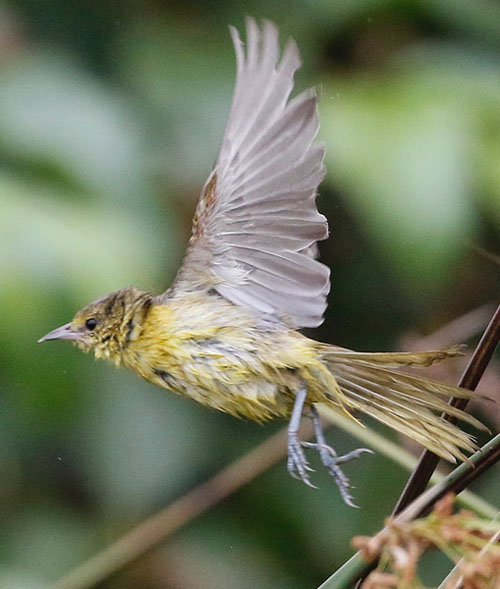 |
 |
 |
|
 Strong northwest winds the night of 29 Sep led to an amazing seawatch from Pt. Pinos on 30 Sep. The wind had subsided, but multitudes of seabirds were flying west, out of the Bay. Brian Sullivan scoped two distant Cook's Petrel, and as he was joined by up to 10 other observers (some of them shown during the seawatch, left, © D. Roberson), the list included two storm-petrels (Ashy & Black), Manx Shearwater, Arctic Tern, two Tufted Puffin (one photo'd) and a juv Horned Puffin (photo'd); see the full list in eBird. Strong northwest winds the night of 29 Sep led to an amazing seawatch from Pt. Pinos on 30 Sep. The wind had subsided, but multitudes of seabirds were flying west, out of the Bay. Brian Sullivan scoped two distant Cook's Petrel, and as he was joined by up to 10 other observers (some of them shown during the seawatch, left, © D. Roberson), the list included two storm-petrels (Ashy & Black), Manx Shearwater, Arctic Tern, two Tufted Puffin (one photo'd) and a juv Horned Puffin (photo'd); see the full list in eBird.
Two rare flycatchers were stars in the third week of September. Last fall, a Great Crested Flycatcher — a vagrant from eastern North America — was discovered on 1 Oct 2022, but was gone by the next morning. This year, another Great Crested Flycatcher was found: on 20 Sep by Brian Sullivan at the Monterey cemetery (photo left below, taken 20 Sep © B.L. Sullivan). This individual, however, lingered to 22 Sep, allowing many others to search for it. It had a habit of disappearing into the crown of live oaks for periods of time, and then 'miraculously' re-appearing atop an oak, often near the eastern fence of the cemetery. This is the 10th record for MTY, all during fall migration. |
|
| The second rare flycatcher was a species that breeds widely in northeastern California but is quite a rare migrant through MTY. On 24 Sep, visiting Sacramento birders Mark Sawyer & Aidan Brubaker came upon a calling Gray Flycatcher in El Carmelo cemetery, Pacific Grove. By the time word spread, the quiet Empidonax with its tail-dipping habit had disappeared. Yet, after a period of nervousness, it was refound in the northeast corner, and was watched/photographed by a Sunday crowd of ~30 birders. One of the throng had a particular reason to be satisfied. For years Rita Carratello has had the second highest list in MTY, but Gray Flycatcher had become her nemesis bird. She had been missing each subsequent record over the decades. No longer a nemesis, her photo of Gray Flycatcher appears at above right (photo 24 Sep © Rita Carratello). To the delight of others, it remained through the following day. |
| |
Most of us lack the ability to divine what the next Monterey County would be. On 17 Sep 2023, if asked, I would have guessed something like "Yellow-crowned Night-Heron," as there were recent records both north and south of us here in MTY. I would not have been close. A bird not on my radar was next in line.
On 17 Sep, Brian Sullivan and Karen Kreiger were working through shorebirds at a restricted-access set of wastewater ponds — there was good variety and a very high number of migrant Semipalmated Sandpipers present (they would tally 87 of those). Sullivan writes, in eBird: "Given the good numbers of Semipalmated Plovers present, we had just discussed keeping our eyes (and ears) open for this species. .. Our initial sighting of [this] juvenile was very brief. We first heard a mellow 'poooee' call that wasn't immediately recognized, but quickly realized that it could be a Common Ringed Plover. There was only one bird standing in the vicinity of where the call came from, so we quickly snapped a few photos of it (photo below left 17 Sep © B.L. Sullivan). Review of the images confirmed that it was indeed a juvenile Common Ringed Plover. Field marks included more striking head pattern, with bolder eyebrow and more extensive dark area between the eye and the bill, with dark extending down to the gape. No eyering was visible, and white from the forehead extended slightly below the eye." |
|
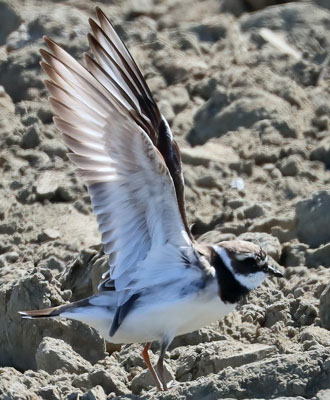 Word went out to permit-holders, who eventually refound the juvenile plover among the many Semipalmateds. Then, even later that same day, another Common Ringed Plover was discovered by Steve Tucker & Adam Searcy. Remarkably, this one was an adult — and it, too, was heard and photographed (photo at left 17 Sep © Steve Tucker). Word went out to permit-holders, who eventually refound the juvenile plover among the many Semipalmateds. Then, even later that same day, another Common Ringed Plover was discovered by Steve Tucker & Adam Searcy. Remarkably, this one was an adult — and it, too, was heard and photographed (photo at left 17 Sep © Steve Tucker).
Both Common Ringed Plovers were present the next day (18 Sep). Terence Degan got a shot of the juvenile (above right 18 Sep © T. Degan) which showed the webbing between the toes of the right foot. There is some webbing between the center and outer toe, but no webbing between the central and inner toe. This is another character that separates Common Ringed from the quite similar Semipalmated Plover.
Common Ringed Plover in an Old World species, breeding in extreme northeastern Canada and a vagrant to Alaska, where there was confirmed breeding on St. Lawrence Island in 1970 (see Roberson 1980). There are just six prior records of Common Ringed Plover in the entire State of California. The first was an adult male at wetlands in Davis, Yolo Co., in Aug 2011. All the others were between Aug–Oct, near the coast, from Del Norte County to Orange County: 4 adults, 1 juv, and one fly-over with call recorded. Now MTY, if approved by the California Bird Records Committee, has added another juvenile and another adult. These represent the first records for Monterey County. |
|
| |
For the first time in over 50 years, a Chimney Swift has been recorded over the Monterey Peninsula. Back in June 1972, Rich Stallcup & Bill Reese watched a swift that they felt confident was a Chimney Swift over Asilomar State Beach; their details were peer-reviewed and published in Audubon Field Notes, later to be called North American Birds. This observation is set against a background of apparent nesting attempts by Chimney Swift in Santa Barbara Co. in 1963 & 1970, and summering Chimney Swifts in Los Angeles that were thought to be "regular" by the mid-1970s. Nesting in Fort Bragg, Mendocino Co. was confirmed in 1975 & 1976; apparent nesting efforts occurred in Yolo Co. in 1975; and in Inyo Co. in 1976 (see "Chimney Swift" account in Calif. Bird Records Committe (2007). The CBRC deemed the species regular enough to stop reviewing claims after just 3 records. Things are different now. Summer records declined in Los Angeles by the late 1990s. In this 21st century, Chimney Swift is again relegated to the status of a rare spring and summer migrant, and one that is quite difficult to identify in the field!
On 16 Sep 2023, Steve Tucker & Adam Searcy watched this Chaetura swift (above right © S. Tucker) with swallows over El Carmelo cemetery in an overcast Pacific Grove. Karen Kreiger was also there and took this photo with a comparative Barn Swallow (lower right © K. Kreiger). The observers favored Chimney over Vaux's Swift on perceived structural and flight differences (including much soaring and gliding), size comparison with swallows, and rump color uniform with back.
Monterey County has five occurrences in spring/early summer 7 May–17 June, one mid-summer (28 July 2006), and now five thought to be late summer/fall migrants (19 Aug–4 Oct). Except for the two P.G. records discussed above, all have been along the Big Sur coast, and all but one were from Andrew Molera SP. Some have lingered for weeks among flocks of Vaux's Swift. I think all the Molera records are swifts compared directly to Vaux's Swift [Vaux's is a common migrant there and a few appear to nest most summers].
|
|
|
 |
Two fine vagrants followed 'hummingbird mania' in the second week of September. Rita Carratello & Don Roberson found a hatch-year Painted Bunting at Pt. Pinos on 8 Sep. Karen Kreiger re-found it later that day at the south edge of the Pt. Pinos golfcourse (photo left © K. Kreiger) before it disappeared for good.
On 13 Sep, Terence Degan found a hatch-year Mourning Warbler at El Carmelo cemetery, close to Pt. Pinos (photo right 13 Sep © T. Degan). It was very secretive and often skulking, but patient observers watched it through 16 Sep.
|
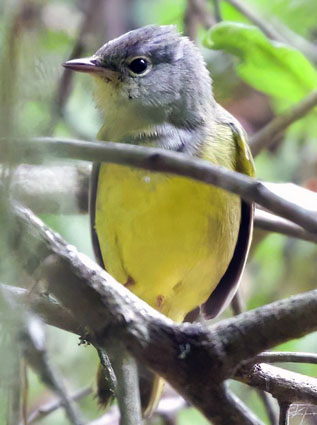 |
|
| |
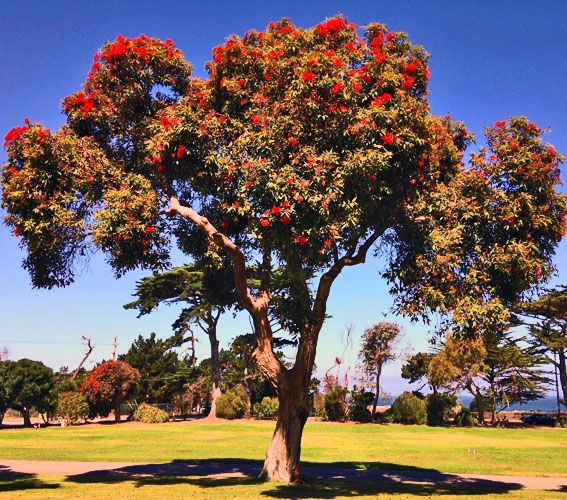
A Tree Grows in Brooklyn is a 1943 novel by Betty Smith. It featured an 11-year-old girl in 1912, living in a Brooklyn tenement, who relies on her imagination and her love of reading as a temporary escape from the poverty of her daily existence. It has become a classic, with the theme that hope and determination can overcome one's upbringing.
A tree grows in El Carmelo, a quiet cemetery in Pacific Grove, and flowers late each summer. It is a non-native Corymbia tree, with one more at each side, that altogether glow with scarlet flowers attracting dozens and dozens of hummingbirds. Since August of 1987, it has been the "go-to" tree to seek scarcer hummers (e.g., Rufous) but also juv Black-chinned Hummingbirds. In eBird there are a dozen records of Black-chins between 2 Aug–29 Sep, and a Black-chinned has been in this tree in half of the most recent 15 years, peaking 25 Aug to 15 Sep. It takes experience and learning the calls of Black-chins to find one among the many swarming Anna's. Photography has become a big help in using details of wing shape and tail patterns. In 2019, a hummingbird photographed between 9-12 Sep proved to be MTY's first Ruby-throated Hummingbird after expert review some weeks later. |
 |
On Monday, 4 Sep 2023, Steve Tucker located an Archilochus hummingbird by its soft “chimp” calls. It was defending a small patch of blossoms, at which it fed regularly, and returned to (mostly) the same perch [in time, birders located that perch from the 'back side']. Steve forwarded this spectacular discovery of a Ruby-throated Hummingbird (photo left, 4 Sep © Steve Tucker) locally, and the Labor Day birders came piling in. |
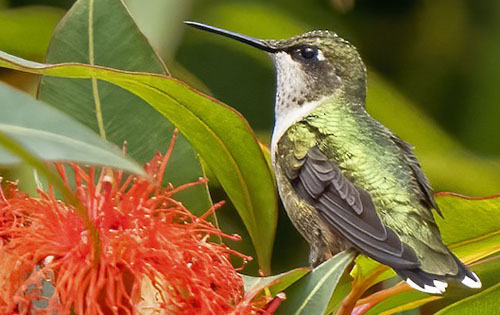 |
Because this juv Ruby-throat was so predictable at its "regular patch" of flowers on 4-5 Sep, photographers gave it a good deal of attention. These photos (Steve's photo above and this perched shot, at left, 4 Sep © Bill Hill) show a number of key identification features: bright emerald green from crown to rump, extensively white below, black 'mask' on face setting off the white throat, medium-length bill, and a tight bunch of narrow inner primaries (p1 to p6) sitting atop the broad p7 on the closed wing — good literature on hummingbird identification includes Williamson (2001) and Howell (2002). |
 |
| All this made for happy times for local birders, as Ruby-throated Hummingbird was a life bird for some, a Monterey County bird for almost everyone, and was lots of fun to photograph among the gorgeous flowers. Among the merry Labor Day participants were, left to right, Francis Toldi, Todd Wills, Fred Hochstaedter, and Catherine Webb. |
. . . but later in the week, with visitors chasing "Ruby" from far and near, trouble was brewing —
Yes. sir, you got trouble, folks, right here in River City, trouble with a capital "T"
[The Music Man, 1957 Broadway musical, by
Meredith Willson] ** |
|
|
| So, as we were saying, there was trouble in a quiet corner of a cemetery in Pacific Grove . . . |
Things were just fine on 4 & 5 Sep, but by 6 Sep, an impostor had arrived arrived. Mark Chappell was the first to suggest that there was a different hummingbird at "Ruby's" set of flowers. Later, from review of photographs, we determined that both the juv Ruby-throated Hummingbird and a juv Black-chinned Hummingbird were present in the same Corymbia tree! They were both present on 6 & 7 Sep, but by 8 Sep only the Black-chin was being photographed. |
| This collage has my 4 Sep Ruby-throat pic & my 9 Sep shot of the Black-chin. Note facial patterns: Ruby-throat with extensive black mask in front and below & behind the eye, with only a tiny white dot behind eye, but Black-chinned has dark only in front of eye and lots of white and dingy gray behind eye. Also green crown on Ruby-throat, grayish crown to Black-chinned. |
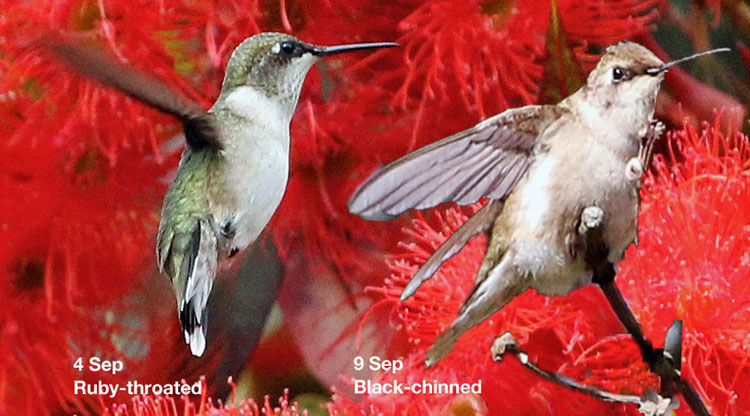 |
| There were also differences in upperpart color and tail pattern. Ruby-throat was green from crown to central rectrices; Black-chin was duller with buffy fringes. The shape of the white tail spots on outer rectrices were different, and r2 had a tiny white tip in Black-chinned. |
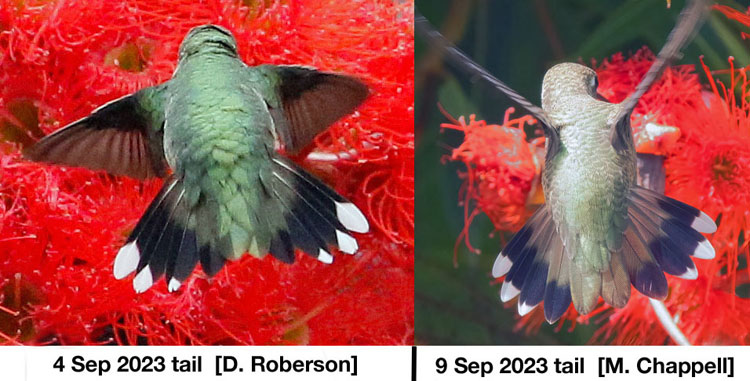 |
| |
Hopefully, we learned something from this experience. For the record, MTY's second Ruby-throated Hummingbird was present 4–7 Sep 2023; a Black-chinned was present from 6–16 Sep in the same tree. |
|
| |
Two impressively early incursions began in August. On 18 Aug, Rita Carratello was the first to report that a Red-breasted Nuthatch was calling in her yard. Normally migrants don't arrive until months later, but by early September, these nuthatches were widespread on the Monterey Peninsula. Numbers increased weekly (photo, 23 Sep © D. Roberson). By month's end hundreds, maybe thousands, were scattered throughout MTY's coastal lowlands. Usually we attribute these early and unpredictable incursions to the collapse of food resources from somewhere in their core breeding range.
Likewise, Red Crossbill irruptions are believed to be related to specific cone-crop failures somewhere north or east of us. On 30 Aug, Alex Lamoreaux, leading a tour in El Carmelo cemetery, tape-recorded a flock of very early crossbills overhead. The spectrograms were reviewed by Tim Spahr and other crossbill experts. As Alex describes it: "the ‘whic whic’ sound (versus the classic ‘jip jip’ [of Ponderosa Pine 'type 2' crossbill), which are displayed on the spectrogram as deep V shapes, confirm this as a Douglas-fir 'type 4' crossbill, which would be the first eBird record for Monterey, and is generally quite rare for central California." Tim Spahr, reviewing recordings continent-wide, said that "having them scattered all over the country right now is just too much fun." These 'Douglas-fir' crossbills were MTY's first ever.
Yet the next group of crossbills at El Carmelo cemetery, by Bill Hubick on 7 Sep (photo right © Bill Hubick), proved to be Western Hemlock 'type 3' crossbills. All the recordings locally since then have been 'type 3'. In years past, Ponderosa Pine 'type 2' crossbills have been the dominant invaders (and have nested occasionally), but we've had 'type 3' crossbills in fall 2012, winter 2015-16, and fall 2017. |
|
|
| |
 On 17 August, David Holway, a visitor walking his dog on the beach at Spanish Bay, Pebble Beach, discovered a Bar-tailed Godwit. His only local contact was to email Don Roberson — fortunately, Don recalled him as one of the finders of a Eurasian Dotterel at Pt. Reyes, Marin Co., back in 1986. After a series of mishaps, Roberson found Holway and the godwit (photo left © D. Roberson), but as the tide came in the bird flew north towards Asilomar SB. Fortune smiled on birders again — it was at a high tide roost at gate 11 at Asilomar, and seen by many. On 17 August, David Holway, a visitor walking his dog on the beach at Spanish Bay, Pebble Beach, discovered a Bar-tailed Godwit. His only local contact was to email Don Roberson — fortunately, Don recalled him as one of the finders of a Eurasian Dotterel at Pt. Reyes, Marin Co., back in 1986. After a series of mishaps, Roberson found Holway and the godwit (photo left © D. Roberson), but as the tide came in the bird flew north towards Asilomar SB. Fortune smiled on birders again — it was at a high tide roost at gate 11 at Asilomar, and seen by many.
It followed the same pattern for two more days: foraging with Whimbrels on sandy beaches at Spanish Bay (photo below 19 Aug © Steve Tucker) and Asilomar (even bathing in the Majella Creek mouth puddle), and roosting with rocky shorebirds at high tide.
This godwit was an adult molting out of breeding plumage and into basic plumage. It was the 4th record of the Siberian subspecies baueri in MTY. The preceding three were juveniles in September (1988, 1994, 2021).
|
 |
|
| |
 Found independently by B.L. Sullivan/Paul Fenwick and Rita Carratello/D. Roberson on 12 Aug (both of whom took photos), this juv Franklin's Gull (photo right 13 Aug © Carole Rose) lingered over 2 weeks, through 29 Aug. It roosted with Caspian Terns and foraged over the freshwater pond near the beach. At 12 August, this youngster was almost the earliest fall record (a juv on 27 July 2000 at the Salinas River mouth was the earliest fall migrant; Jim Booker, D. Roberson). At the time of the publication of Monterey Birds, 2d ed. (Roberson 2002), there were 62 MTY records: half spring migrants and the other half fall migrants (with an occasional winter bird). We still average about 1-2 Franklin's Gull each year, still pretty much equally balanced between spring and fall. Found independently by B.L. Sullivan/Paul Fenwick and Rita Carratello/D. Roberson on 12 Aug (both of whom took photos), this juv Franklin's Gull (photo right 13 Aug © Carole Rose) lingered over 2 weeks, through 29 Aug. It roosted with Caspian Terns and foraged over the freshwater pond near the beach. At 12 August, this youngster was almost the earliest fall record (a juv on 27 July 2000 at the Salinas River mouth was the earliest fall migrant; Jim Booker, D. Roberson). At the time of the publication of Monterey Birds, 2d ed. (Roberson 2002), there were 62 MTY records: half spring migrants and the other half fall migrants (with an occasional winter bird). We still average about 1-2 Franklin's Gull each year, still pretty much equally balanced between spring and fall.
Other interesting August shorebirds included a Solitary Sandpiper, two Stilt Sandpiper, and ~5-6 juv Semipalmated Sandpiper between 5 Aug-1 Sep in the lower Salinas Valley. In September, among rare landbirds not covered in detail above, included an Eastern Kingbird, two Red-eyed Vireo, two Magnolia Warbler, a Blackburnian Warbler. and a 30 Sep Philadelphia Vireo that lingered well into October (it may be covered in more detail then).
|
Two unusual birds / bird phenomena had backgrounds that arose earlier in the summer. First, on 28 June, Seth Glassett saw a large white swan in flight northwards as he drove along Highway 1 near Garrapata SP. The next day, 29 June, Bill Hill reported a Tundra Swan at the Carmel River lagoon (we presume it was the swan seen the day before; photo below from 2 July © Mark Chappell).
A Tundra Swan along the Big Sur coast or at Carmel is rare enough, but a swan in summer is unprecedented. When Monterey Birds, 2d ed. was published (Roberson 2002) there were no summer records at all, and this is the very first in eBird this century. Migratory swans from the Central Valley have sometimes lingered into May, but they were believed to be sick or injured. This adult had a full set of remiges and could fly, and was not banded. It actively foraged in both the Carmel lagoon and the Odello side-lagoons, and was seemingly healthy. It was present until 6 Sep. Otherwise, Tundra Swan had previously been seen in MTY only between November and March, so this occurrence was notable. |
Off the California coast, a warming trend in ocean temperatures that began earlier in the year became a full-fledged El Niño by August. Sea surface temperatures west of Monterey Bay, usually in the mid-50s°F, rose into the mid-60s, bringing with it tropical fish and birds. A research trip on 4 Sep had a Red-billed Tropicbird in 68° waters (Evan Brodsky).
Warm waters offshore often bring Scripps's Murrelet, but in really warm-water years we hope for Craveri's and Guadalupe Murrelets (the latter the rarest at this latitude). All 3 species were well offshore by August, but surprisingly, later trips that month and in September found only Guadalupe Murrelet (photo below from 17 Sep © Mark Chappell. It breeds the farthest south of any of the 3 similar murrelets, and is identified by its white face, mostly surrounding the eye. In the last 10 years, there have been only a handful of records from 2015, 2017, and 2021. Also notable were sightings of Craveri's Murrelet from Pt. Pinos on 21 Aug (2; D. Roberson), 23 Sep (1; B.L. Sullivan, K. Kreiger), and 30 Sep (3; Paul Fenwick). |
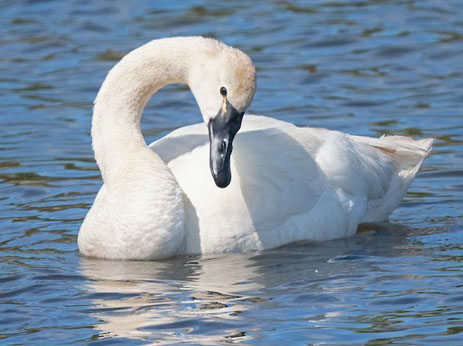 |
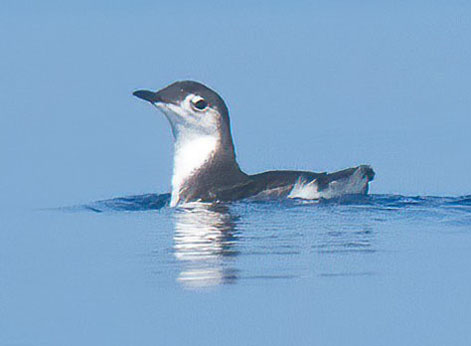 |
|
| |
July 2023 opened with a surprising booby at Pt. Pinos, and before the month was out, MTY had recorded 3 species of tropical boobies. First, a Red-footed Booby has been roosting on moored sailboats in Monterey Harbor since at least 10 May. The booby flies out into Monterey Bay each day to forage, but returns by evening. It was present all July and still remains into September. It must be doing well as each time we see it, it looks healthy, the bill is more highly colored, and red feet seem brighter (photo right 17 Sep, © Mark Chappell).
Second, on 1 July, Elizabeth & Gabriel Olin, visitors from Oakland, found a Masked Booby roosting at Pt. Pinos. It mostly slept, but then flew off allowing clear views of the wing and tail. This shot (below, © E. & G. Olin) is a screen-cap of a hand-held video through a scope. This was just the 4th Masked Booby for MTY, all adults.
Third, on 20 July, Della Bossart spotted a white booby among the Brandt's Cormorant colony at famed Bird Rock along 17 Mile Drive. Identified that evening as a subadult Nazca Booby (by D. Roberson), it was harassed by territorial cormorants. The next day it was perched on the Pebble Beach mainland near China Rock (Steve Tucker), and was still there 21 July (photo below right, © Bill Hubick) — see more of the story below the photos. There are now ~23 records of Nazca Booby in MTY. |
 |
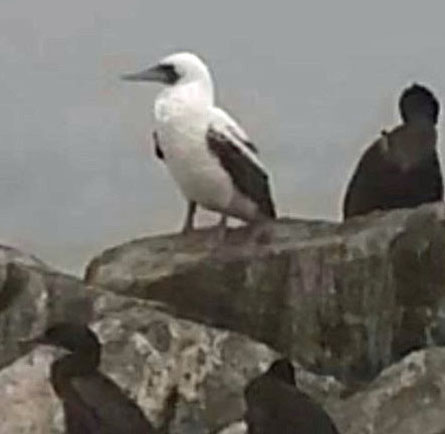 |
 |
|
As to Nazca Booby this summer, observers on 20 & 21 July became concerned because the bird seemed to be lethargic and had a wound on its back (was it pecked hard by cormorants?). The local SPCA was called and they took it into their wildlife care facility, provided food and medicine, and forwarded it to a better equipped Bay Area facility. Sadly, this booby did not survive. It became a specimen in the bird collection at U.C. Davis. The taxidermist who prepared the specimen advised me (D. Roberson, pers. com.) that it looked to have been starving and had intestinal parasites. Blood and tissue samples are available if anyone wished to do molecular research.
Bill Hubick relates an interesting back-story that he recalled upon seeing this Nazca Booby: "Six years ago I was visiting Monterey with my family (we moved here later, in 2019) and I was delighted to get an hour to scan at Point Pinos. It was 7/18/2017. I remember being thrilled to count 50+ Common Murres flying by. Some guy on a bike stopped and asked if I was looking for the booby. I said 'I am now!' That was Mark Kudrav, who found that [Nazca Booby at the Point], and I later scanned with Todd Wills. Good timing! I now live here and both of them are friends. Six years almost to the day!" |
| |
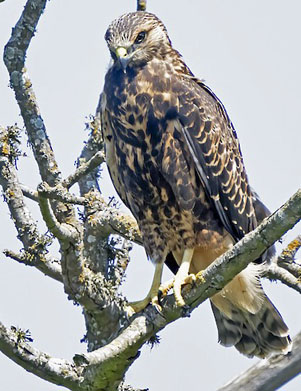 |
In the preceding report, we documented the first known nest of Swainson's Hawk in the lower Salinas Valley since 1915 (Roberson 2002), and the first breeding pair in Monterey County in about 50 years. Again a party of local birds obtained permission to visit the breeding site to see if the baby in the nest had fledged. The visit was successful: the fresh juvenile was seen with an adult on the ground, apparently eating, and then flew to a perch (photo left 12 Aug © Bill Hill).
Given the juvs very fresh state of plumage, with some rectrices still growing in, and rather ungainly flight, we suspect that it fledged within the week. This would push back our hypothetical chronology, commented upon last update, by ~10 days. In the new hypothesis, the egg would have been laid in late May, and the young hatched about 30 June, give or take 4-7 days?
Another interesting behavior was that when an adult Red-tailed Hawk flew towards the landfill but happened to pass over the spot on the ground that we later found the fledgling, the adult male Swainson's dive-bombed that Buteo very aggressively, so that the Red-tail departed that air-space quickly.
Many more photos from various photographers, plus audio and more commentary, are in the eBird record of 12 Aug 2023. |
|
| |
Literature cited:
- California Bird Records Committee (R.A. Hamilton, M.A. Patten & R.A Erickson, eds). 2007. Rare Birds of California. West. Field Ornith., Camarillo, CA.
- Howell, S.N.G. 2002. Hummingbirds of North America: the Photographic Guide. Academic Press, London, UK, and San Diego, CA.
- Roberson, D. 1980. Rare Birds of the West Coast. Woodcock Publ., Pacific Grove, CA.
- Roberson, D. 2002. Monterey Birds, 2d ed. Monterey Audubon Soc., Carmel, CA.
- Roberson, D., and C. Tenney, ed. 1993. Atlas of the Breeding Birds of Monterey County, California. Monterey Audubon Soc., Carmel, CA.
- Williamson, S.L. 2001. Hummingbirds of North America. Peterson Field Guides. Houghton Mifflin Harcourt Publ., New York.
I thank Rita Carratello and Michael Rieser for editorial comments on an earlier draft of this page.
** Meredith Willson's childhood in Mason City, Iowa, inspired the fictional town of River City, where “The Music Man” takes place. Rita and I visited Mason City in June 2017, as evidenced by eBird checklist https://ebird.org/checklist/S37558392, but I digress
|
|
Page created 22 Sep-22 Oct 2023
TOP
GO TO
HOME PAGE
TO MONTEREY
COUNTY
PAGE
TO BIRD
FAMILIES
OF THE WORLD
|



 Strong northwest winds the night of 29 Sep led to an amazing seawatch from Pt. Pinos on 30 Sep. The wind had subsided, but multitudes of seabirds were flying west, out of the Bay. Brian Sullivan scoped two distant Cook's Petrel, and as he was joined by up to 10 other observers (some of them shown during the seawatch, left, © D. Roberson), the list included two storm-petrels (Ashy & Black), Manx Shearwater, Arctic Tern, two Tufted Puffin (one photo'd) and a juv Horned Puffin (photo'd); see
Strong northwest winds the night of 29 Sep led to an amazing seawatch from Pt. Pinos on 30 Sep. The wind had subsided, but multitudes of seabirds were flying west, out of the Bay. Brian Sullivan scoped two distant Cook's Petrel, and as he was joined by up to 10 other observers (some of them shown during the seawatch, left, © D. Roberson), the list included two storm-petrels (Ashy & Black), Manx Shearwater, Arctic Tern, two Tufted Puffin (one photo'd) and a juv Horned Puffin (photo'd); see 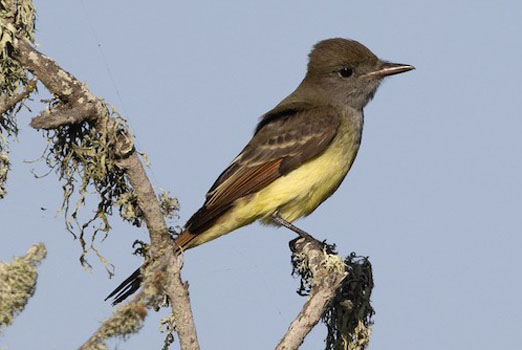

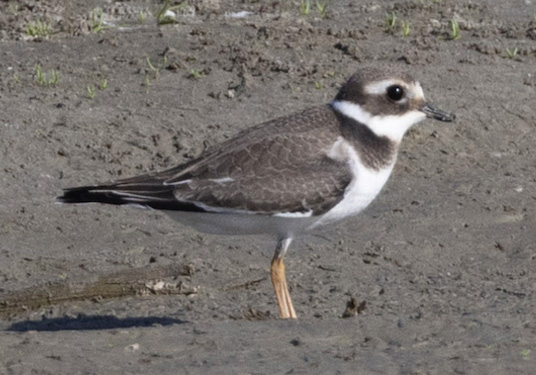
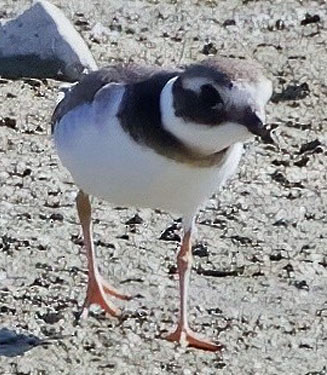
 Word went out to permit-holders, who eventually refound the juvenile plover among the many Semipalmateds. Then, even later that same day, another Common Ringed Plover was discovered by Steve Tucker & Adam Searcy. Remarkably, this one was an adult — and it, too, was heard and photographed (photo at left 17 Sep © Steve Tucker).
Word went out to permit-holders, who eventually refound the juvenile plover among the many Semipalmateds. Then, even later that same day, another Common Ringed Plover was discovered by Steve Tucker & Adam Searcy. Remarkably, this one was an adult — and it, too, was heard and photographed (photo at left 17 Sep © Steve Tucker).









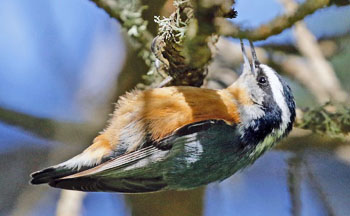

 On 17 August, David Holway, a visitor walking his dog on the beach at Spanish Bay, Pebble Beach, discovered a Bar-tailed Godwit. His only local contact was to email Don Roberson — fortunately, Don recalled him as one of the finders of a Eurasian Dotterel at Pt. Reyes, Marin Co., back in 1986. After a series of mishaps, Roberson found Holway and the godwit (photo left © D. Roberson), but as the tide came in the bird flew north towards Asilomar SB. Fortune smiled on birders again — it was at a high tide roost at gate 11 at Asilomar, and seen by many.
On 17 August, David Holway, a visitor walking his dog on the beach at Spanish Bay, Pebble Beach, discovered a Bar-tailed Godwit. His only local contact was to email Don Roberson — fortunately, Don recalled him as one of the finders of a Eurasian Dotterel at Pt. Reyes, Marin Co., back in 1986. After a series of mishaps, Roberson found Holway and the godwit (photo left © D. Roberson), but as the tide came in the bird flew north towards Asilomar SB. Fortune smiled on birders again — it was at a high tide roost at gate 11 at Asilomar, and seen by many. 
 Found independently by B.L. Sullivan/Paul Fenwick and Rita Carratello/D. Roberson on 12 Aug (both of whom took photos), this juv Franklin's Gull (photo right 13 Aug © Carole Rose) lingered over 2 weeks, through 29 Aug. It roosted with Caspian Terns and foraged over the freshwater pond near the beach. At 12 August, this youngster was almost the earliest fall record (a juv on 27 July 2000 at the Salinas River mouth was the earliest fall migrant; Jim Booker, D. Roberson). At the time of the publication of Monterey Birds, 2d ed. (Roberson 2002), there were 62 MTY records: half spring migrants and the other half fall migrants (with an occasional winter bird). We still average about 1-2 Franklin's Gull each year, still pretty much equally balanced between spring and fall.
Found independently by B.L. Sullivan/Paul Fenwick and Rita Carratello/D. Roberson on 12 Aug (both of whom took photos), this juv Franklin's Gull (photo right 13 Aug © Carole Rose) lingered over 2 weeks, through 29 Aug. It roosted with Caspian Terns and foraged over the freshwater pond near the beach. At 12 August, this youngster was almost the earliest fall record (a juv on 27 July 2000 at the Salinas River mouth was the earliest fall migrant; Jim Booker, D. Roberson). At the time of the publication of Monterey Birds, 2d ed. (Roberson 2002), there were 62 MTY records: half spring migrants and the other half fall migrants (with an occasional winter bird). We still average about 1-2 Franklin's Gull each year, still pretty much equally balanced between spring and fall. 




